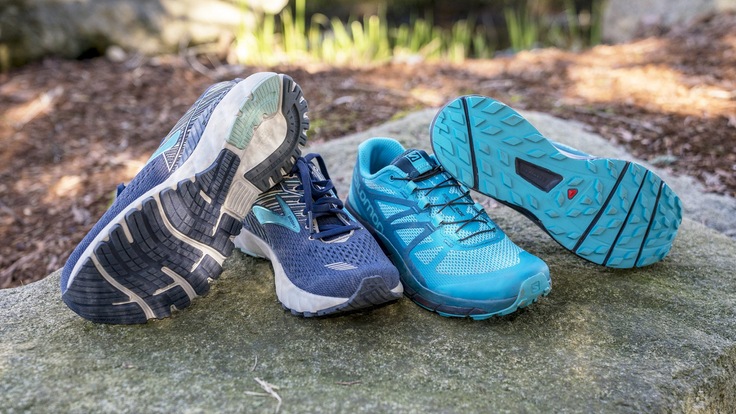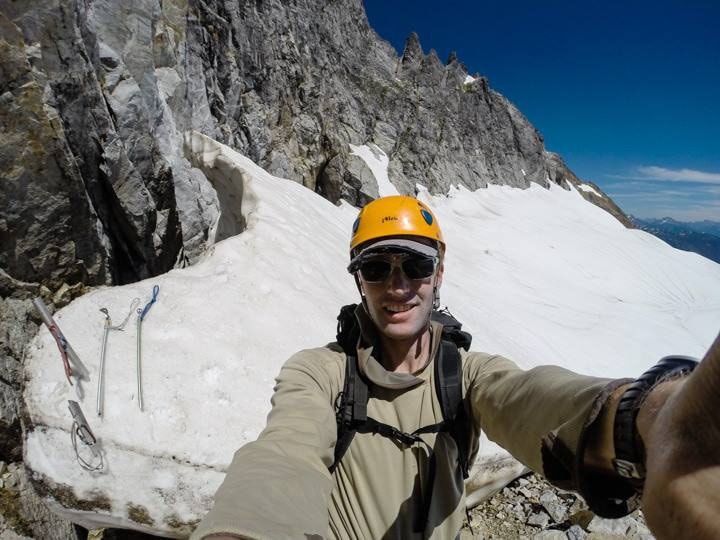Hold a trail-running shoe up next to a road-running shoe and you'll be able to spot a few differences in how they look and feel. But what do those differences mean for performance? And do you really need to own a pair of both? To help you figure things out, we're going to break down what distinguishes trail-running shoes from road-running shoes from the ground up.
Compared to road-running shoes, trail shoes have:
- Beefier outsoles: The outsoles on trail-running shoes typically have bigger, softer lugs for better traction on trails, whereas road-running shoes tend to have flatter, smoother, more-durable soles for running on pavement.
- Stiffer midsoles: Trail-running shoes usually have stiffer midsoles than road-running shoes to create a more stable platform on uneven terrain. And, they sometimes include rock plates for protection against sharp rocks and sticks. Road-running shoes typically have softer midsoles for cushion while pounding the pavement.
- Reinforced uppers: The uppers on trail-running shoes are reinforced for protection from rocks, roots and sticks on the trails. Road-running shoes don't require this, which means they are usually a touch lighter and more breathable.
Trail-Running vs. Road-Running Shoe Outsoles
One of the most visible differences between trail and road-running shoes is in the outsoles (the bottoms of the shoes).
Trail-running shoes have bigger lugs for better grip while going over rocks, roots and uneven trail. The size and pattern of the lugs vary based on the type of terrain the shoes are designed for, so it's best to match your shoes to the surface you'll be running on. Also, the rubber is typically softer than what's on road shoes so that it can grab and bend around obstacles in the trail for good grip. Because of the softer rubber, wearing trail-running shoes on the road, where they will regularly pound and rub on hard pavement, can wear the soles out more quickly than if you stick to the softer surface of a trail.
Road-running shoes have flatter, less-knobby soles to create a stable, consistent surface for running on paved roads. The rubber generally holds up better to frequent friction with paved surfaces than the rubber on trail shoes.
Trail-Running vs. Road-Running Shoe Midsoles
The midsole is the cushioning and stability layer of a shoe located between the outsole and upper.
Trail-running shoes are generally stiffer through the midsoles for more support on rugged trails and uneven surfaces. Some trail-running shoes include rock plates between the midsoles and outsoles that add protection against sharp objects, like rocks and sticks, without taking away too much of the feel of the trail. The height of the midsoles and the drop (the height difference between the heels and toes) can vary quite a lot based on how the shoes are intended to perform and feel on your feet (this is also true for road shoes). The right amounts of cushion and drop for you are largely based on personal preference, but your anatomy and the terrain play a part, too.
Road-running shoes don't require the same stiffness as trail shoes in the midsoles, but still need to protect feet from pounding the pavement. They typically do this by incorporating softer cushioning in the midsoles than you'll find in trail-running shoes. Road shoes sometimes include things like medial posts and torsion bars. These are located on the sides of shoes to help control excessive inward or outward motion. They are designed for the over-pronato or supinator.
Trail-Running vs. Road-Running Shoe Uppers
The uppers of shoes are everything above the midsoles and are usually made from breathable materials like polyester, nylon and nylon mesh.
Trail shoes are built more rugged than road shoes to protect the shoes and your feet from things you'll encounter on your run, like rocks, roots and sticks. This means the uppers are frequently reinforced with synthetic overlays in key spots, like around the toes, heels and sides of the shoes.
The uppers of some trail-running shoes have waterproof linings or coatings to help keep moisture out. Waterproof shoes can be nice for wet conditions, but it's good to know that if moisture does get in, it won't be able to drain out as easily as it would in non-waterproof shoes.
A couple other features you'll find on the uppers of some trail-running shoes are lace pockets on the tongues and gaiter attachment points on the heels and/or toes. The lace pockets (sometimes called lace garages) are handy for stuffing the loops of your laces into so they won't get caught on roots, rocks and sticks while you're running. The gaiter attachment points make it easy to securely attach gaiters to help keep dust, mud, rocks, water and snow out of your shoes.
When you're running on a paved service, it's unlikely that your shoes will rub up against any obstacles. For this reason, road shoes don't need much reinforcement in the uppers and instead have lots of mesh to keep the shoes lightweight and breathable.




